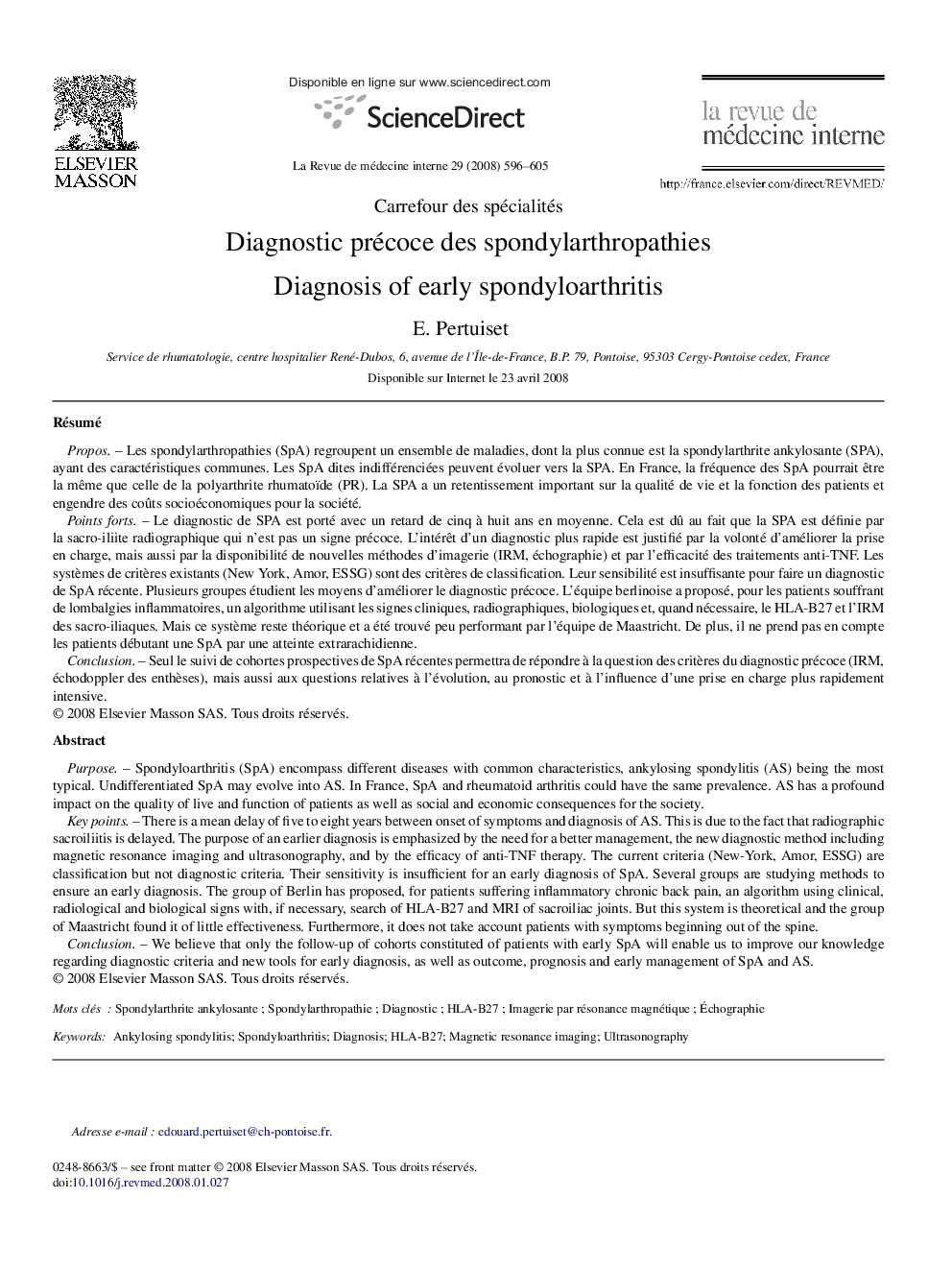| کد مقاله | کد نشریه | سال انتشار | مقاله انگلیسی | نسخه تمام متن |
|---|---|---|---|---|
| 3022828 | 1182419 | 2008 | 10 صفحه PDF | دانلود رایگان |

RésuméProposLes spondylarthropathies (SpA) regroupent un ensemble de maladies, dont la plus connue est la spondylarthrite ankylosante (SPA), ayant des caractéristiques communes. Les SpA dites indifférenciées peuvent évoluer vers la SPA. En France, la fréquence des SpA pourrait être la même que celle de la polyarthrite rhumatoïde (PR). La SPA a un retentissement important sur la qualité de vie et la fonction des patients et engendre des coûts socioéconomiques pour la société.Points fortsLe diagnostic de SPA est porté avec un retard de cinq à huit ans en moyenne. Cela est dû au fait que la SPA est définie par la sacro-iliite radiographique qui n’est pas un signe précoce. L’intérêt d’un diagnostic plus rapide est justifié par la volonté d’améliorer la prise en charge, mais aussi par la disponibilité de nouvelles méthodes d’imagerie (IRM, échographie) et par l’efficacité des traitements anti-TNF. Les systèmes de critères existants (New York, Amor, ESSG) sont des critères de classification. Leur sensibilité est insuffisante pour faire un diagnostic de SpA récente. Plusieurs groupes étudient les moyens d’améliorer le diagnostic précoce. L’équipe berlinoise a proposé, pour les patients souffrant de lombalgies inflammatoires, un algorithme utilisant les signes cliniques, radiographiques, biologiques et, quand nécessaire, le HLA-B27 et l’IRM des sacro-iliaques. Mais ce système reste théorique et a été trouvé peu performant par l’équipe de Maastricht. De plus, il ne prend pas en compte les patients débutant une SpA par une atteinte extrarachidienne.ConclusionSeul le suivi de cohortes prospectives de SpA récentes permettra de répondre à la question des critères du diagnostic précoce (IRM, échodoppler des enthèses), mais aussi aux questions relatives à l’évolution, au pronostic et à l’influence d’une prise en charge plus rapidement intensive.
PurposeSpondyloarthritis (SpA) encompass different diseases with common characteristics, ankylosing spondylitis (AS) being the most typical. Undifferentiated SpA may evolve into AS. In France, SpA and rheumatoid arthritis could have the same prevalence. AS has a profound impact on the quality of live and function of patients as well as social and economic consequences for the society.Key pointsThere is a mean delay of five to eight years between onset of symptoms and diagnosis of AS. This is due to the fact that radiographic sacroiliitis is delayed. The purpose of an earlier diagnosis is emphasized by the need for a better management, the new diagnostic method including magnetic resonance imaging and ultrasonography, and by the efficacy of anti-TNF therapy. The current criteria (New-York, Amor, ESSG) are classification but not diagnostic criteria. Their sensitivity is insufficient for an early diagnosis of SpA. Several groups are studying methods to ensure an early diagnosis. The group of Berlin has proposed, for patients suffering inflammatory chronic back pain, an algorithm using clinical, radiological and biological signs with, if necessary, search of HLA-B27 and MRI of sacroiliac joints. But this system is theoretical and the group of Maastricht found it of little effectiveness. Furthermore, it does not take account patients with symptoms beginning out of the spine.ConclusionWe believe that only the follow-up of cohorts constituted of patients with early SpA will enable us to improve our knowledge regarding diagnostic criteria and new tools for early diagnosis, as well as outcome, prognosis and early management of SpA and AS.
Journal: La Revue de Médecine Interne - Volume 29, Issue 7, July 2008, Pages 596–605